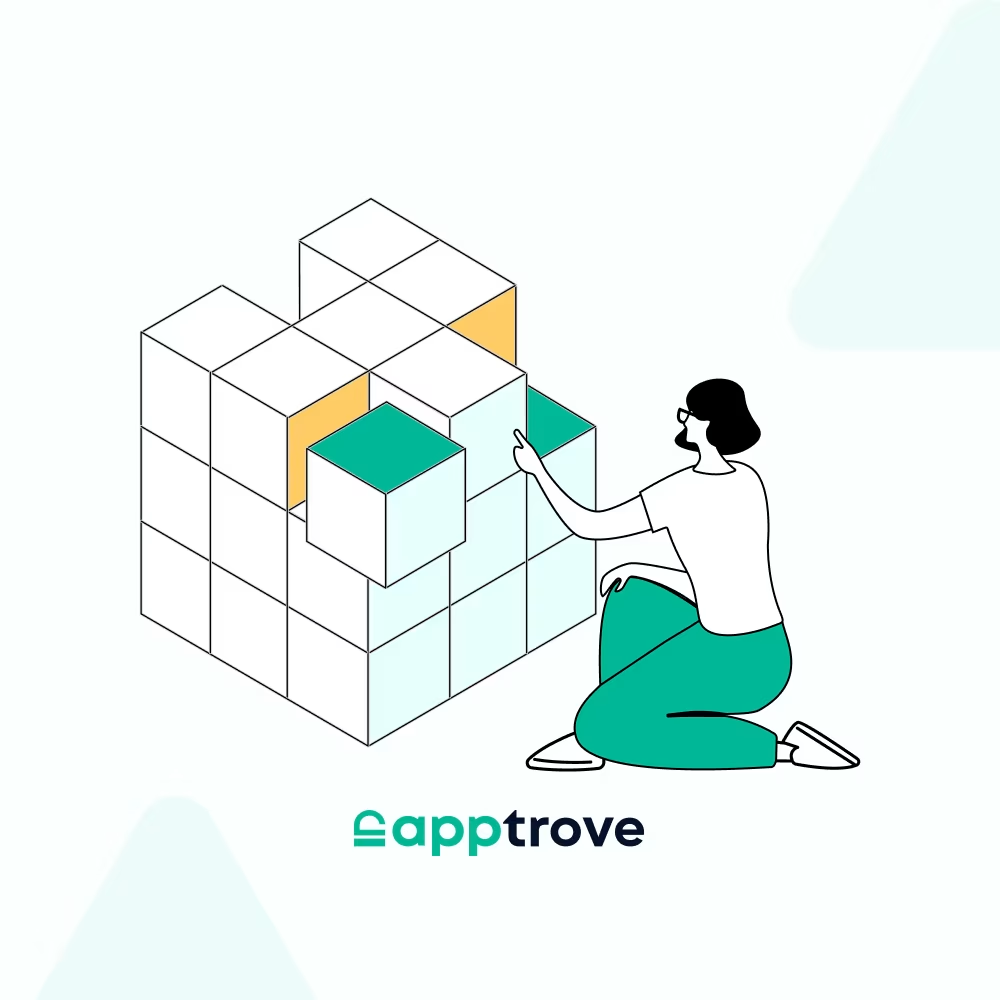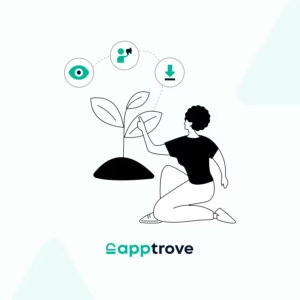Introduction
That feeling when you hit 10,000 mobile app installs? It’s electric. Like finally getting that nod of approval you’ve been chasing since launch day. But trust me, the leap from 10K to a million is a whole different ball game. It’s not about catching lightning in a bottle anymore. It’s about building a systematic approach, creating strategies that actually stick, and really getting inside your users’ heads to understand why they download, why they stay, and why they come back for more.
If you’re handling app marketing or product development, you already know the real headache isn’t just getting bigger numbers, it’s building growth that actually lasts. The kind that doesn’t fall apart when your acquisition costs start climbing (and they will). As your campaigns scale up, your cost per install tends to follow the same upward curve. Without solid attribution or a clear picture of who’s sticking around, you’ll burn through cash on channels that look good on paper but don’t deliver loyal users. One day, you’ll look up and realize your growth chart has flatlined, but your spending definitely hasn’t.
That’s why I put this guide together. No fluff, no theoretical nonsense—just real strategies that have helped apps scale and increase mobile app installs using Apptrove‘s toolkit. We’ll walk through building an acquisition funnel that doesn’t leak like a sieve, how to keep people engaged long after they’ve downloaded, and how to make user retention and lifetime value the backbone of sustainable growth.
Whether you’re sitting at 10K downloads wondering what’s next, or pushing toward 100K and hitting roadblocks, consider this your practical roadmap to one million installs—with purpose and direction, not just blind momentum. And here’s the kicker: it’s not about throwing more money at the problem. It’s about finding what’s already working in your data and scaling it with surgical precision.
Ready to dig in? Let’s go.
Stage 1: Strategies for Your First 10K Mobile App Installs
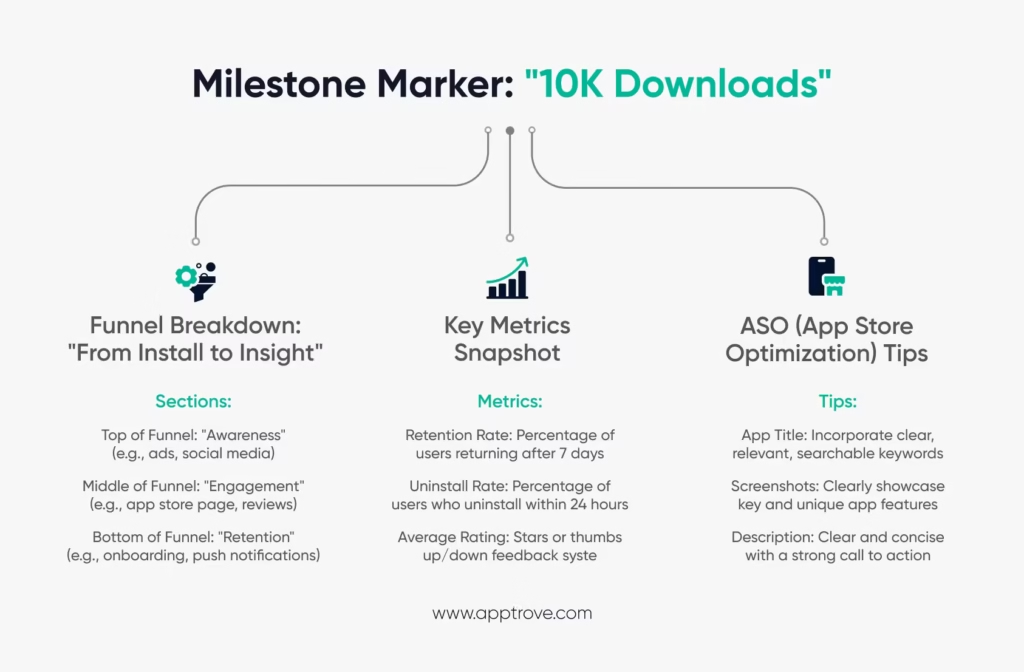
Those first 10,000 mobile app installs aren’t just a vanity metric—they’re the beginning of your real story. This is where the rubber meets the road. Every download, every uninstall, every frustrated or delighted review gives you clues about what’s clicking and what’s falling flat.
Your focus here needs to be laser-sharp. When your budget’s tight and your team is stretched thin, you can’t afford to spray and pray. You need to zero in on channels that bring quality users through the door, fine-tune your App Store Optimization (ASO) until it hums, and craft an experience that makes people actually want to come back tomorrow.
The Strategic Value of 10K Mobile App Installs
Think of those first 10K as your foundation, not just a milestone to celebrate and forget. This is when patterns start to emerge, what convinces someone to tap “install,” where they get frustrated and bail, and what features keep them hooked.
- It shows if your product and marketing are actually singing the same tune: Are people sticking around without being nudged? Are they telling friends? Or is something still missing from the equation?
- It reveals which messages actually land: That headline that seemed clever in the brainstorm? That screenshot you debated for hours? Now you know which ones actually moved the needle.
- It sets your benchmark for success: These early adopters define what “normal” looks like for every batch of users that follows.
- It gives you algorithmic juice: Those downloads and reviews feed the app store algorithms, and your early momentum helps new users stumble across you naturally.
Treat this phase like your laboratory, not your finish line, and everything that follows becomes infinitely more scalable.
Optimizing Your App Store Optimization (ASO) Strategy for Maximum Organic Growth
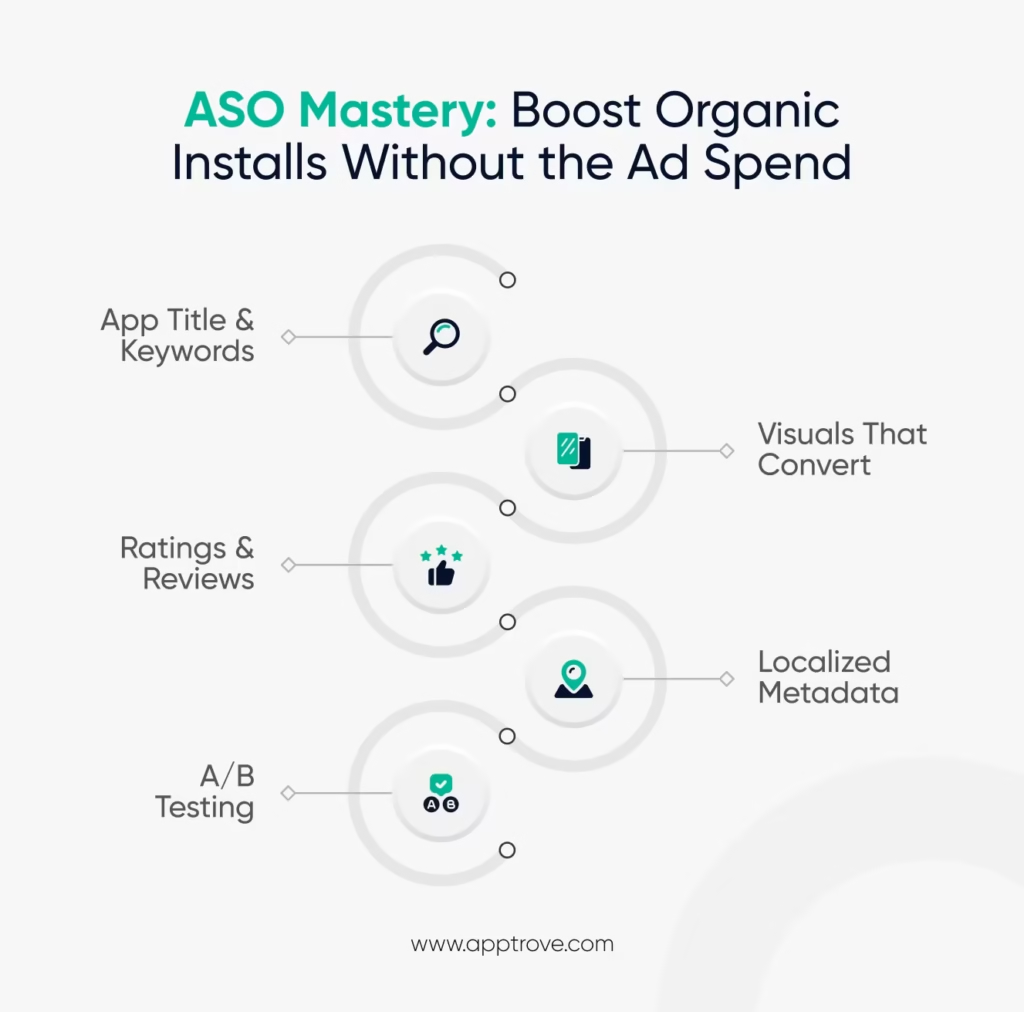
Before you start throwing money at paid campaigns, squeeze every drop out of your organic potential to increase mobile app installs. ASO isn’t just a box to check—when budgets are tight, it’s your secret weapon.
Crafting App Title & Keywords for App Store Optimization (ASO) Success
Your app title should speak the same language as your ideal users. Are they looking for a “sleep tracker” or a “meditation guide”? A “recipe collection” or a “meal planner”? Make sure those exact words show up front and center. Tools like Apple’s keyword search or Sensor Tower can show you what terms are heating up in your category.
Creating Visuals That Drive Conversion Rate
Skip the generic pretty interfaces—your screenshots should showcase actual “wow” moments. Show your core features solving real problems. A quick preview video that explains your app’s magic in everyday language can dramatically impact your conversion rate and inspire more mobile app installs.
Leveraging Ratings & Reviews
Nothing builds trust faster than seeing other people’s positive experiences. Ask satisfied users for feedback when they’re riding high—right after they’ve completed a workout, saved their first recipe, or hit any meaningful milestone. Even a handful of genuine 5-star reviews can transform both your ranking and how many visitors convert to users.
Implementing Localized Metadata
Got your eyes on users beyond your home country? Localize early. Even if your app itself stays the same, thoughtfully translated descriptions and culturally relevant screenshots can make a serious impact. In fact, apps that localized their metadata saw up to a 128% increase in downloads within just one week of launching in a new language. That’s not just a lift—it’s a strategic advantage. Localization helps users feel like your app was built for them, making your app store presence significantly more persuasive in global markets.
A/B Testing Your Store Presence
Never settle for your first draft. Play around with different app icons, screenshot sequences, and description formats. Apple’s Product Page Optimization and Google Play Experiments make this easier than ever, and the results might challenge your assumptions about what works.
Conversion Rate Optimization Techniques for Mobile Apps
Getting eyeballs on your app store page is only half the battle. The harder part? Turning those visits into actual downloads.
First impressions happen in milliseconds. Your app’s core value needs to hit like a ton of bricks. What painful problem do you solve? Why should anyone care? Don’t make potential users scroll through paragraphs to figure out why they need you in their lives.
But landing the download isn’t the finish line. That first in-app experience can make or break everything. It should guide users straight to their “aha!” moment—whether that’s tracking their first run, saving their first recipe, or whatever magic moment defines your particular app.
And please, don’t overlook your onboarding flow. Too many sign-up hoops, permission requests, or confusing first screens absolutely murder your conversion rate. Keep it smooth, intuitive, and rewarding at every step.
Make sure what you promise in your ads matches what people find in your store listing. If your ad talks up one killer feature, but your store page highlights something completely different, people feel misled—and they bounce.
Reducing Cost Per Install From Day One
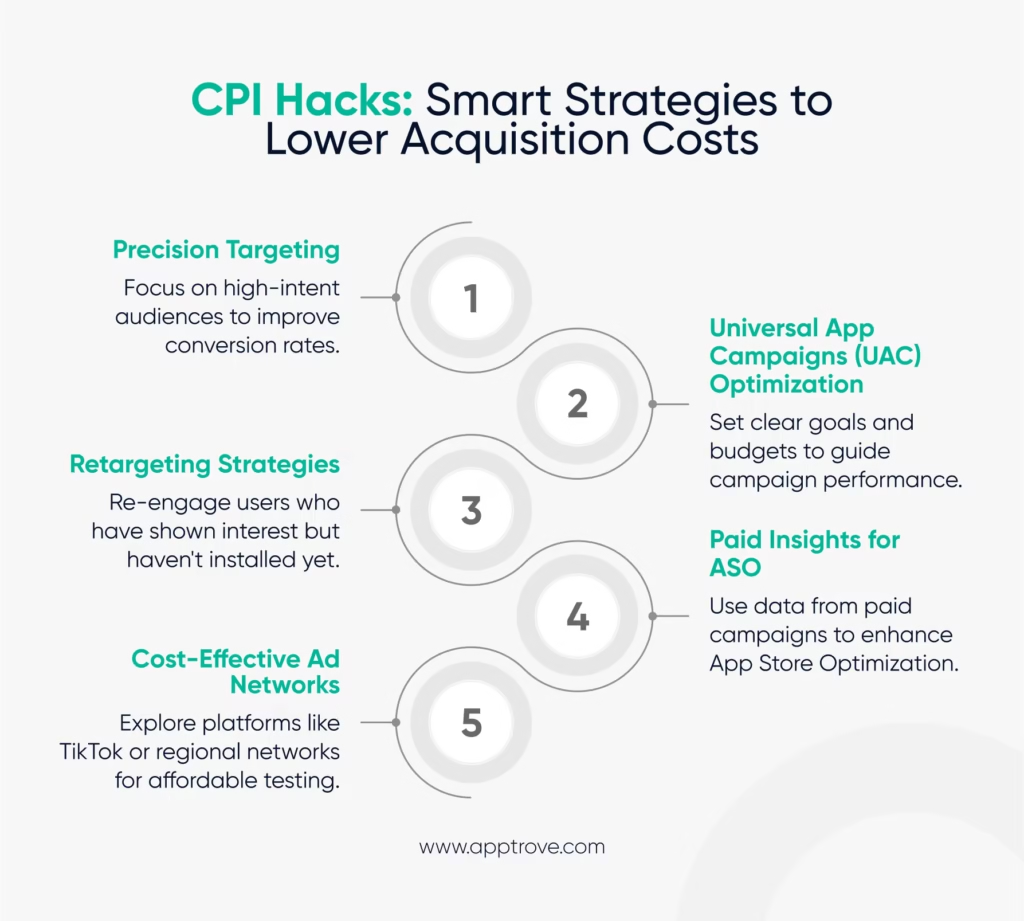
While organic growth builds a solid foundation, a smart, targeted paid campaign can help you hit 10K faster, especially when you’re testing new audience segments or fresh creative approaches.
But keeping your cost per install under control is crucial. Here’s how to prevent budget bleed:
Precision Targeting for Lower Cost Per Install
Forget going wide—go deep instead. Start with a narrow, high-intent audience slice. Look for users already showing signs they’re searching for exactly what you offer.
Optimizing Universal App Campaigns for Mobile App Installs
Feed your UACs with strong creative assets and crystal-clear goals. Base your initial CPI targets on patterns you’ve already seen from organic users. Let the real-world performance data guide your bidding strategy, not hunches or industry benchmarks.
Retargeting Strategies to Improve Conversion Rate
Even early on, don’t overlook retargeting. Users who downloaded but quickly disappeared might just need a gentle reminder—or a better first experience. Bringing them back often costs far less than finding brand-new users.
Using Paid Insights to Enhance App Store Optimization (ASO) Performance
When you discover which headlines convert like crazy or which keywords drive the most installations, don’t keep that intelligence siloed. Feed those insights right back into your App Store Optimization (ASO) strategy. Your paid and organic efforts should constantly learn from each other.
Testing Cost-Effective Ad Networks for Mobile App Installs
Platforms like TikTok or regional ad networks can give you affordable testing grounds while you’re still figuring things out. Just make sure you’re tracking quality signals, not just raw download numbers.
Stage 2: Moving from 10k to 100k Users

You’ve successfully crossed that first 10,000 download milestone. Congratulations! This achievement means you’ve confirmed real market demand, refined your positioning, and started building genuine momentum. Now it’s time to accelerate. But growing from 10k to 100k users isn’t simply about throwing more money at the same strategies; it’s about scaling with intention, keeping your acquisition costs under control, and developing systems that you can measure, repeat, and optimize for efficiency.
At this pivotal stage, you’re transitioning from pure experimentation to focused optimization. Paid campaigns, influencer partnerships, and creative testing become increasingly important, but they’ll only deliver results if you’ve established strong foundations with effective onboarding, crystal-clear messaging, and design that encourages people to take action.
Optimizing Growth Strategies Without Blowing Your Budget
When pushing beyond 10k users, it’s tempting to simply increase spending on whatever channels worked before. But what got you to this point won’t necessarily carry you to 100k, at least not in a cost-effective way.
Here’s how to scale intelligently without watching your budget spiral out of control:
Double Down on What’s Working, But Segment. If Facebook delivered strong results in your early stages, don’t just increase the overall budget — segment it strategically. Break campaigns down by geographic location, specific audience interests, different lookalike audience layers, and diverse ad creative approaches. Small, thoughtful adjustments can dramatically impact performance.
Start Building a Multi-Channel Mix. Diversify your user acquisition channels early. Test a variety of approaches to increase mobile app installs:
- Google’s advertising tools for broad, intent-driven reach
- TikTok Ads for connecting with Gen Z and creating visual-first engagement
- Contextual ads are placed within apps that your target users already actively use
Your goal is to avoid becoming overly dependent on any single source while gaining clear insights into which channels deliver your most valuable users.
Leverage Influencer & Creator Marketing, Micro-influencers and niche content creators can drive highly engaged new users, especially when their content feels authentic and native to their platform. Focus on:
- Real, practical use cases, not just generic app mentions
- Short-form demonstrations (on Instagram Reels, YouTube Shorts, TikTok)
- Trackable links that enable proper return-on-investment measurement
This approach is often more affordable than traditional display advertising, and users typically trust it more.
Referral Loops Still Work — If Done Right, Give your users meaningful incentives to share your app. Go beyond generic “earn coins” rewards — offer something truly valuable that connects directly to your core experience. Make the sharing process completely seamless. One-tap referral systems can become powerful growth engines when integrated thoughtfully into onboarding flows or post-purchase experiences.
Experiment with Strategic Partnerships. Could you co-market with a complementary app? Create a bundle with a relevant product? Arrange features in established newsletters or online communities? These relatively low-cost, high-trust channels often drive quality traffic at scale.
How to Improve User Adoption Through Better Onboarding
With 10K+ users, even a seemingly modest 5% improvement in how many people complete your signup process or accomplish their first key action can translate into thousands of additional active users monthly, without spending an extra dollar on advertising.
Here’s how to optimize your onboarding flow for maximum impact:
Map the First 60 Seconds: What single action represents success for a new user? Design your entire first-minute experience around guiding users toward that specific goal. Ruthlessly eliminate any step that doesn’t directly contribute to this outcome.
Use Progressive Disclosure: Rather than overwhelming new users with an intimidating wall of features or lengthy sign-up forms, gradually reveal value as they progress. For example, let users explore core functionality first, then prompt for account creation once they’re already engaged and seeing benefits.
Personalized Onboarding Flows: Use available data (from ad source, location, or demographics) to customize the onboarding experience. If someone arrives from a fitness-focused advertisement, prioritize showing workout-related benefits first. This approach significantly increases engagement and builds trust from the very beginning.
Contextual Nudges and Tooltips: Instead of front-loading extensive tutorials, implement timely, in-app guidance. When a user encounters a feature for the first time, explain it in that moment, not during the initial app introduction sequence.
Lowering Your User Acquisition Costs at Scale
As your spending increases, maintaining control over how much it costs to bring in each new user becomes absolutely essential. Without careful management, even apparent “growth” can quickly become unsustainable.
Here’s how to keep your acquisition costs healthy while scaling effectively:
Creative Refresh Cycles: Ad fatigue is a very real phenomenon. Implement a system to rotate fresh creative assets every 10–14 days. Test multiple approaches:
- Value-based messaging compared to feature-focused communication
- Authentic user testimonials versus polished product UI demonstrations
- Short-form (6–10 seconds) versus slightly longer video advertisements
Track performance by specific creative assets, not just by channel.
Use Smart Bidding Strategies: Transition from manual bidding to goal-oriented bidding approaches once you’ve accumulated sufficient data. This enables advertising platforms to optimize in real time for bringing in users who are most likely to engage meaningfully with your app.
Geographic & Device Targeting: Not all markets or devices deliver equal return on investment. Concentrate resources on geographies or operating system versions where your engagement and retention metrics show stronger performance. Implement cost-based filters to maximize your return on ad spend.
Reconnect With Almost-User: Re-engage people who showed initial interest but didn’t complete downloading your app, or those who downloaded but disappeared before reaching key activation points. These audience segments are typically more affordable to win over than completely new prospects.
Measurement Matters: Implement reliable tracking tools to monitor real-time performance across all your campaigns. Without accurate data, any attempt to optimize your marketing spending becomes little more than educated guesswork.
Stage 3: Scaling from 100K to 1 Million Mobile App Installs
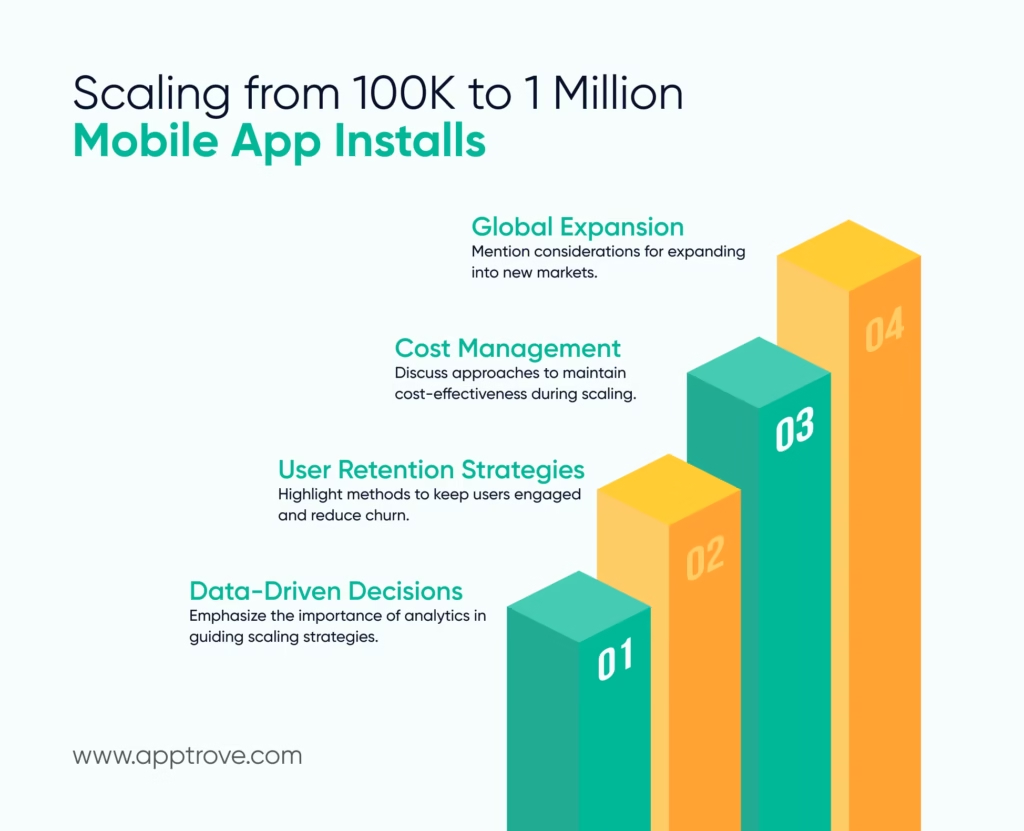
Reaching 100K users is a significant milestone that confirms you’ve built something people genuinely want — now it’s time to transform that success into a truly scalable growth engine. But the journey to a million users isn’t simply about accumulating more mobile app installs. It’s about systematically improving efficiency, strengthening retention, and maximizing long-term user value.
This advanced stage requires evolving beyond purely acquisition-focused tactics toward a more comprehensive strategy, where every decision is supported by concrete data, and every dollar spent is carefully optimized across the entire user journey: from that initial click all the way through to lifetime value.
Let’s explore how to grow sustainably without depleting your budget or losing your hard-won users.
Data-Driven Growth: What to Measure & Why
At this critical juncture, gut feelings and intuition simply won’t suffice. You need sophisticated, real-time data feedback loops that inform every strategic decision.
Move from Installs to Activation Metrics: You’ve successfully generated installs — now track what users actually do after downloading:
- Time to first key action (TKA)
- Activation rate (percentage of installs that lead to first valuable action)
- Specific drop-off points during onboarding and the initial session
These metrics help you precisely identify where and why you’re losing potential engaged users.
Lifetime Value Over Vanity Metric: Pursuing vanity metrics like “daily install counts” can be misleading. Instead, focus on metrics that reveal genuine business impact:
- CLV (Customer Lifetime Value) is carefully segmented by acquisition source
- ARPU (Average Revenue Per User)
- Cohort retention rates broken down by acquisition channel
Understanding which user segments generate substantial value helps you allocate spending more intelligently.
Predictive Segmentation: Leverage historical behavior patterns to identify users who are likely to churn, convert to paying customers, or become particularly high-value users. Feed these sophisticated segments into targeted retargeting or strategic upselling campaigns to maximize your return on investment.
Performance Dashboards That Tell a Story: Develop intuitive, role-specific dashboards that deliver actionable insights. For instance:
- Growth teams monitor cost per install trends and creative ROAS (return on ad spend)
- Product teams track feature-level engagement metrics
- CRM teams access churn prediction indicators and campaign performance lifts
When your team can clearly see the narrative within your metrics, they naturally make more informed decisions.
Retaining Users with Personalization & Deep Linking
Acquisition brings users through the door. But retention transforms them into genuine business value. The longer users remain active, the more value they generate, and the lower your effective cost per install becomes over time.
Here’s how to keep them coming back consistently:
Use Deep Linking to Drive Contextual Journeys: Effective deep linking ensures users land precisely where value exists, not on a generic homepage. Whether it’s:
- A special promotion from a push notification
- A shared recommendation link from an existing user
- A targeted re-engagement advertisement
Deep links significantly reduce friction and boost reactivation rates. Apptrove’s Unilink technology allows you to create personalized, cross-platform deep links with sophisticated real-time routing — perfect for both acquisition and retention strategies.
Personalization Based on Behavior: Develop dynamic in-app experiences that adapt to individual users.
- Recommend specific features based on each user’s unique usage history
- Display personalized offers, tips, or tutorials aligned with behavior patterns
- Customize push notification content and timing to individual preferences
This approach transforms your app from a generic one-size-fits-all tool into a personalized companion tailored to each user’s specific needs.
Build Habit Loops: Retention improves dramatically when users form consistent habits around your app. Consider implementing:
- Achievement streaks and timely reminders (like Duolingo’s approach)
- Daily rewards or fresh content drops (common in games and news applications)
- Progress indicators that reset with daily login activity
The ultimate goal: make return visits feel both valuable and necessary to the user’s routine.
Churn Prevention Triggers: Implement proactive inactivity triggers to identify churn risk and intervene before users fully disengage:
- No activity after 3 days? Trigger a personalized “We miss you” push notification
- User opened but didn’t complete the signup? Offer a limited-time incentive to finish
- User dropped off after just one session? Showcase “What’s new” highlights to rekindle interest
This proactive approach helps maintain a stable, engaged user base.
Scaling Campaigns While Keeping Cost Per Install in Check
Your marketing budget is growing substantially now, but cost per install creep presents a real challenge. The larger your spending becomes, the easier it is to lose efficiency unless every component of your campaign strategy is precisely optimized.
Diversify Channels Based on User Quality: Not all acquisition channels scale with equal effectiveness. Measure not just basic CPI metrics, but downstream impact as well:
- Which specific sources deliver higher LTV or superior retention rates?
- Which audience segments show higher conversion rates within your app?
- Which creative themes consistently perform well across multiple channels?
Let comprehensive ROI metrics, not simply reach potential, drive your media allocation decisions.
Creative Intelligence at Scale: In performance marketing, your creative assets function as critical growth levers. Build a sophisticated creative development pipeline that’s:
- Fast-moving: Implement weekly or bi-weekly testing cycles
- Strategically focused: Develop different messaging for each funnel stage (e.g., initial install vs. re-engagement)
- Feedback-driven: Utilize heatmaps, scroll depth data, and detailed ad interaction metrics
Then, leverage advanced tools like dynamic creative optimization (DCO) to systematically automate what demonstrably works.
Leverage High-Intent Retargeting: Don’t overlook valuable user segments who:
- Visited your store page but didn’t complete the installation
- Installed your app, but never reached activation
- Activated initially but stopped using the app
Retargeting these specific segments (via Meta, Google, or in-app advertising networks) typically costs significantly less than acquiring completely new users, and often converts more quickly.
Automate Budget Allocation by Performance: Implement rules-based automation or AI-powered platforms to dynamically redistribute budget across campaigns, creative variations, and geographic regions based on:
- CPI threshold triggers
- Event-based ROI metrics (like purchases or subscription conversions)
- Detailed retention trend analysis
The fundamental goal: continuously allocate more resources to your highest-performing channels in real time.
Global Expansion: Localized Scaling: Looking to reach a million users rapidly? Consider strategic expansion into Tier 2 and Tier 3 markets. However, success requires:
- Thoroughly localizing creative assets and app store listings
- Thoughtfully adapting value propositions (recognizing that what resonates in one market may fall flat in another)
- Carefully adjusting pricing structures, payment options, and customer support approaches
Apptrove’s analytics help you track these crucial geo-level insights, enabling truly informed expansion decisions.
Growth Accelerators & Must-Have Tools
Scaling an app successfully goes far beyond simply hitting download milestones—it’s about thoughtfully building a system that can support and accelerate growth for the long haul. That system? It’s what we call your growth stack: the right mix of tools to increase mobile app installs, key metrics, and repeatable processes that drive progress at every stage. And yes, it makes a measurable difference. According to Instabug, apps that improve their rating from three to four stars can see up to an 89% increase in downloads—just by focusing on performance and user experience.
Let’s explore the essential accelerators that help app marketers evolve from implementing occasional growth tactics to operating a sophisticated growth engine.
Key Metrics to Track Beyond Installs
Many marketers make the mistake of shopping at basic install counts, but that’s really just the beginning of the story. True, sustainable growth lives in the post-install actions and what they reveal about user behavior.
Here’s what you should be mentioning closely:
Activation Rate: What percentage of users actually complete your app’s core action (whether that’s completing signup, making a transaction, etc.) after installing?
Retention (Day 1, 7, 30): Are your users sticking around long enough to discover genuine value in your app?
Session Frequency: How often are they returning- daily, weekly, or less frequently?
LTV & ARPU: Which specific user segments are truly profitable? Which acquisition channels are bringing these valuable users to your app?
Churn Rate: At what points are you losing users, and more importantly, why are they leaving?
These deeper metrics enable you to make significantly smarter decisions, eliminate wasted spending, and thoughtfully align your product roadmap with genuine user needs and behaviors.
That’s precisely where sophisticated tracking and attribution tools like Apptrove become invaluable. They allow you to trace every install, engagement action, or purchase back to its original source, giving you a much clearer understanding of what’s actually driving meaningful growth.
Role of Deep Linking in Post-Install Engagement
Imagine this scenario: a potential user sees your compelling Instagram ad and decides to install your app. What happens in those critical moments after installation?
If they simply land on your generic homepage with no context, there’s a high probability you’ll lose their interest immediately. However, with strategic deep linking implementation, you can guide them directly to the specific experience that motivated their click in the first place, whether that’s a particular product page, an attractive discount offer, or a demonstration of a featured capability.
Deep links = significantly less friction, substantially more conversions.
Apptrove’s Unilink technology makes this process seamless, creating intelligent deep links that automatically adapt based on:
- The user’s specific platform (iOS, Android, or web)
- The original campaign source that brought them to you
- Their unique behavior patterns and demonstrated preferences
You can also comprehensively track the complete post-install journey: from initial click to installation, through subsequent in-app actions, all the way to repeat purchases and long-term engagement. This capability is absolutely essential for optimizing your conversion funnel and creating personalized user experiences at scale.
Think of deep linking as the vital connective tissue between your acquisition strategies and retention efforts — a seemingly small technical detail that can have a truly massive impact on your results.
App Store Optimization Is Not a One-Time Task
Many app developers mistakenly treat App Store Optimization (ASO) like a simple launch checklist item that can be completed and forgotten. In reality, it functions as an always-on growth lever that requires ongoing attention.
Why? Because both your users’ needs and your competitors’ strategies are constantly evolving.
Here’s how to ensure your App Store Optimization (ASO) efforts remain fresh and effective over time:
- Revisit keywords regularly: Are you currently ranking for the most relevant search terms? Have competitors begun outranking you for crucial keywords?
- Optimize creative assets: Systematically A/B test your app icon, screenshots, and preview video. These visual elements directly impact your mobile app install conversion rates.
- Update your description: Continuously refresh your listing to reflect new features, incorporate social proof, and highlight recent updates.
- Leverage ratings & reviews: Strategically prompt satisfied users to leave positive ratings, and consistently respond to both positive and negative feedback.
Strong, ongoing App Store Optimization (ASO) efforts don’t just improve your visibility in crowded app stores — they also significantly enhance your conversion rate once potential users discover and land on your store page. This dual benefit effectively lowers your cost per install across both organic discovery and paid acquisition channels.
Checklist – Before You Scale
Before you eagerly chase after that next big user milestone, take a moment to ask yourself an honest question: Is your app genuinely ready to scale?
Real scaling isn’t simply about bringing more users through the door—it’s about creating a healthy environment where meaningful growth can actually sustain itself. I’ve seen countless apps rush headfirst into pouring money into paid acquisition before addressing fundamental issues in their product. The predictable result? Impressive install numbers on paper, but disappointingly low engagement, users who vanish almost immediately, and marketing budgets that seem to evaporate with little to show for it.
Start by looking inward with a critical eye. Is your app truly stable when more people use it? Are new users discovering real value quickly, or are they dropping off right after installation? Have you genuinely validated product-market fit—not just with raw download numbers, but with meaningful usage patterns and authentic user feedback? Having a smooth, intuitive onboarding experience, a well-optimized App Store Optimization ASO setup, and a functioning feedback system from your early adopters isn’t just nice to have—it’s absolutely essential.
From the marketing perspective, make sure every campaign you launch is firmly grounded in actual data. If you’ve already experimented with paid acquisition channels, carefully review what actually converted users and really understand why. Have you thoroughly tested different creative formats to see what resonates? Do you have a clear picture of your current conversion rate benchmarks across different channels? You’re in an even stronger position if you’ve already implemented sophisticated deep linking and attribution tools early in your journey, allowing you to connect every single install back to measurable outcomes.
Above all, don’t make the common mistake of equating scaling with speed alone. Growth works most effectively when you’ve methodically laid the groundwork—when your App Store Optimization (ASO strategy is freshly updated, your messaging speaks clearly to your target audience, and your entire team shares a unified understanding of what success truly looks like beyond simply counting downloads.
If you’re consistently seeing healthy retention patterns, reasonable activation rates across new user cohorts, and at least one organic growth loop beginning to generate results, chances are you’re genuinely ready to transition from cautious experimentation to confident expansion.
Final Thoughts – Scale With Intention, Not Just Speed
The journey of growth is undeniably exciting, but it should never come at the expense of clarity and purpose. Successfully scaling an app isn’t merely about reaching that impressive one million mobile app install milestone, it’s about truly understanding what those installations actually lead to in the real world.
In today’s increasingly competitive market, it’s temptingly easy to become fixated on surface-level metrics that look good in reports. But genuinely sustainable growth always goes much deeper. It’s about continuously improving how users experience your app from that very first moment of discovery all the way through to the crucial point when they make the decision to stay—and ideally, keep coming back time after time.
Every single strategy and tactic I’ve shared throughout this guide—from thorough ASO optimization to conversion rate fine-tuning, from sophisticated paid acquisition approaches to thoughtful re-engagement campaigns—centers around one fundamental goal: helping you build something with genuine staying power. The secret isn’t about spending more money just to grow faster; it’s about spending more intelligently, testing consistently with purpose, and carefully building upon the foundation that’s already demonstrating real results.
If your upcoming phase of growth demands more precise attribution insights, significantly stronger user engagement, and smarter install tracking capabilities, Apptrove has been specifically designed to support you throughout that journey. Our comprehensive toolkit helps you gain a crystal-clear understanding of where your users originally come from, how they actually behave after installing your app, and exactly how to enhance both your retention metrics and overall return on investment.
Scale with genuine purpose and direction. Built with data-driven insight and understanding. And when you’re truly ready to transform those initial downloads into something far more valuable, Apptrove is right here to help you every step of the way, keeping your cost per install efficient while maximizing the lifetime value of every user you acquire.


